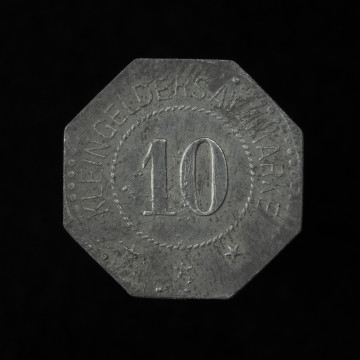
10 pfennig
circa 1917
National Museum in Szczecin
Part of the collection: Scrip
Numismatists claim that during the First World War, small coins disappeared from the German money market in three ways. Some were withdrawn by government institutions in order to run the war, some were taken out by the public for various purposes. A large number of small coinage was also involuntarily transported out of the country by German soldiers on leave returning to the front. National mints, which struggled with capacity and raw material and sometimes even with manpower to operate the machinery, were unable to make up for these deficits. Retailers using small coins on a daily basis found themselves at a dead end. Although various replacements for small denominations sprang up, they could not replace the durable and practical metal money in circulation. It was therefore decided that local authorities needed to shoulder the responsibility for its production. Replacement money in particularly scarce denominations, especially 10 pfennig, began to be ordered from private estates. The state mostly turned a blind eye to the issuing of replacement coins. However, granting official permission was out of the question and never followed. Instead, efforts were made to get issuers to redeem replacement money as soon as possible. During the period of the coin deficit, the town of Wolin issued its own money in 1918 and 1919 with denominations of 10 and 25 pfennigs. Following the trend prevailing since the end of 1917, the 1918 coins were struck in iron, while those of 1919 were already produced in zinc. They were commissioned from Jörgum & Tretz in Frankfurt am Main. The featured 10 pfennig coin belongs to the second series. It was struck in zinc, despite the fact that from the end of 1917 this metal was considered a strategic material and was difficult to access. Mieszko Pawłowski
Other names
10 Pfennig, Notgeld
Author / creator
Object type
token coin
Technique
coining
Material
zinc
Origin / acquisition method
purchase
Creation time / dating
Creation / finding place
Owner
Muzeum Narodowe w Szczecinie (1945- )
Identification number
Location / status

circa 1917
National Museum in Szczecin

1923
National Museum in Szczecin

1923
National Museum in Szczecin
DISCOVER this TOPIC
Museum of King Jan III's Palace at Wilanów
DISCOVER this PATH
Educational path